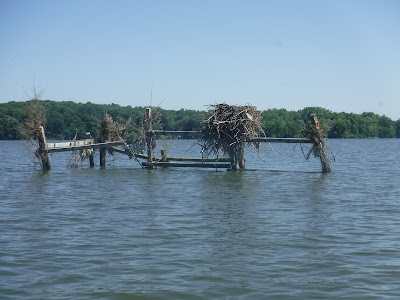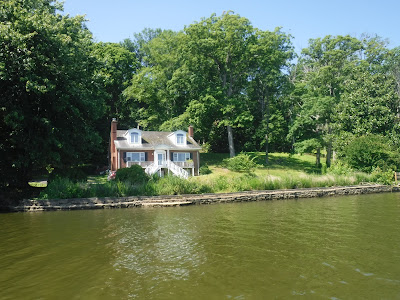Wednesday, June 29, 2022
Hi Blog!
The other day we stopped to check out Pohick Bay Regional Park in Lorton, VA. We have reservations to stay in their campground next March and were curious about the location. After a walking around the campground, we went down to the marina. We were impressed with the boat launch and the surrounding estuary. We decided that after our six mile hike yesterday, today would be a good day to paddle.
Just as we were getting ready to shove off, a busload of summer campers joined us. Their camp counselors barked orders as the their young charges began unloading pontoons, rudders and sails from their trailer. We managed to sneak out before they launched.
Just beyond the boat launch was a wooden structure that might have once been a duck blind. Today, it is a nesting platform for an osprey family.
As we paddled up the bay toward the entrance of Pohick Creek, we noticed several small objects bobbing along the surface. We managed to scoop a couple up and discovered they were empty snail shells. Some poor hermit crab is missing his condo.
Pohick is a Native American word that means “the water place”. The land along the south side of the bay was purchased for park purposes in the late 1960s, and by 1972 the park was opened. As we paddled along the shoreline, we noticed there were still a couple houses within the park boundaries. From a quick Zillow search, it appears these properties were not part of the park purchase.
As we made our way further up the bay, we were followed by an osprey who kept checking our wake to see if we stirred up any fish.
On the north side of Pohick Bay is Fort Belvoir, a census-designated place and home to a number of significant United States military organizations. With nearly twice as many workers as The Pentagon, Fort Belvoir is the largest employer in Fairfax County.
All around the bay, we noticed various duck blinds. Fort Belvoir's waterfowl hunting program manages the blinds. The waterways are divided into 3 zones and contain a total of 26 blinds, each blind holds 4 hunters. Zones are rotated throughout the week to provide resting/foraging/loafing for bald eagles and waterfowl. All blinds are open on Saturdays, and all blinds are closed on Tuesdays and Thursdays.
We found a few bird boxes along the shoreline. They appear to have seen better days. Despite the rundown housing conditions, over 198 different birds have been seen in Pohick Bay.
Each blind we encountered has its own personality.
In addition to the bird boxes, a number of osprey platforms were along the creek channel. While osprey generally prefer higher accommodation, this heron thought the platform made a great perch to watch the fish swim by.
As we made our way upstream we startled a bald eagle and he flew from his perch in front of us. We didn't notice, at first, that there were actually two bald eagles. The second one stayed behind.
Pohick Bay Regional Park is located on the Mason Neck. The Mason Neck peninsula was inhabited by the first nations Doeg people prior to the arrival of European settlers. The recorded history of Mason Neck began around 1755 with the construction of Gunston Hall, the plantation house of George Mason, author of the Virginia Declaration of Rights. Today, great white egrets ply the waters of the former plantation.
In addition to bald eagles, Mason Neck is home to a variety of animal species. Birds include great blue herons, Canada geese, ospreys, wood ducks, teal, owls, and woodpeckers. Whitetail deer are common, along with beavers, muskrats, groundhogs, and foxes. A diverse population of frogs and toads can be heard on summer nights. Eastern box turtles, eastern snapping turtles, wood turtles, and spotted turtles can all be found around ponds, streams, and marshes, as well as snakes, such as the northern copperhead and the northern black racer.
Two egrets sitting in a tree....k-i-s-s-i-n-g! First comes love, then comes marriage -- soon they'll be pushing a baby carriage! :)
Native to the Middle East and Asia, the mimosa tree was brought to this country in 1785 by the famous French botanist Andre Michaux, who planted it in his botanic garden in Charleston, South Carolina. Thriving in the southern climate, the plant grew quickly into a vase-shaped, flat-topped tree that reached 30- to 40-feet tall. The flowers, attractive to butterflies, hummingbirds, and colonial gardeners, ranged in color from nearly red to deep pink to flesh-pink to white.
We found a beachy spot for lunch in the shadow of one of the old bird boxes. We noticed the water level was dropping. We didn't check the tide charts to see if Pohick Bay was affected by tide change. We decided to play it safe and head back into the main part of the bay where tide change wouldn't affect our paddling.
The cormorant is a prehistoric-looking, matte-black fishing bird with yellow-orange facial skin. Though they look like a combination of a goose and a loon, they are relatives of frigate birds and boobies and are a common sight around fresh and salt water across North America—perhaps attracting the most attention when they stand on docks, rocky islands, and channel markers, their wings spread out to dry. These solid, heavy-boned birds are experts at diving to catch small fish.
The Osprey is unique among North American raptors for its diet of live fish and ability to dive into water to catch them,. Ospreys are common sights soaring over shorelines, patrolling waterways, and standing on their huge stick nests, white heads gleaming. These large, rangy hawks do well around humans and have rebounded in significant numbers following the ban on the pesticide DDT.
We couldn't resist bagging one last duck blind.
As the afternoon warmed up, we made our way back to the boat launch. It was an all-out race between us and the summer camp kids to see who would make it back first. We won!
We really enjoyed our time on Pohick Bay and hope to explore other parts of the bay in the future. The July 4th Holiday is fast approaching and we'll be busy with lots of family and kid activities. It may be a few days before we can blog again. Until then, keep smiling!



















No comments:
Post a Comment
Note: Only a member of this blog may post a comment.